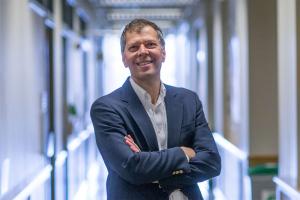
If the United States is going to reach its goal of providing 35% of its electric consumption from wind energy by 2050, researchers have to figure out what to do when the wind doesn’t blow.
“We rely on conventional energy production such as plants fired by natural gas and coal to take over when the wind isn’t blowing,” said Eric Loth, University of Virginia Rolls-Royce Commonwealth Professor of mechanical and aerospace engineering and an expert in wind energy systems. “However, reaching deep decarbonization of the U.S. grid would require us to replace most of the carbon-emitting plants that provide power during peak usage with renewable energy storage, to take care of times when the wind isn’t blowing."
Loth joined other thought leaders from Harvard University, Johns Hopkins University, the Massachusetts Institute of Technology, Howard University, the University of Colorado and the Colorado School of Mines to develop a first-of-its-kind roadmap that integrates wind and energy storage and demonstrates how communities, governments and researchers can work together at the design stage to consider social, technical, economic and political challenges and opportunities to create successful wind energy projects.
Their findings were published Sept. 21 in Joule, a top peer-reviewed journal for energy research worldwide.
“Big ideas that crop up in wind energy research can take up to 10 years before they are installed at a large scale,” Loth said. “They can have 20-year lifetimes, too, so it is critical to start researching these new systems now for the future energy grid.”
Many of the challenges the team is working on are technological, such as how to transfer and store energy when the wind isn’t blowing, how to connect to the power grid effectively and how to control the turbines themselves.
“My area of expertise is in the modeling and control of dynamical systems such as wind turbines. Advanced turbine controls can maximize the efficiency of capturing wind and converting it into electricity. The better the efficiency, the lower the cost, and the more aligned we will be with consumer needs," said Lucy Y. Pao, Palmer Endowed Chair Professor in the Electrical, Computer and Energy Engineering Department at the University of Colorado Boulder.
The team’s roadmap can also incorporate the location choices of large wind farms and storage systems, and how the communities rank the importance of affected landscape features, such as mountains or ocean views.
“The roadmap helps assist with decision-making and tailoring a solution to specific community needs," said Dennice F. Gayme, an associate professor in the Department of Mechanical Engineering at Johns Hopkins University. “For example, incorporating battery banks near substations with the largest load density may be the best technical and economic solution, but this may lead to unwanted infrastructure nearby and within large population centers.”
The collaborative design approach between communities, governments and researchers “allows stakeholders to assess the technological components of a proposed system and weigh the tradeoffs of different designs depending on a specific community and regional needs,” Gayme said.
To ensure success, the roadmap incorporates social and economic factors that researchers feel should not be separated from the technological issues.
“While wind energy will play a crucial role in meeting our climate goals, it is still industrial development that can redistribute benefits, risks, and harms for different populations,” said Jessica Smith, professor in the Department of Engineering, Design & Society at the Colorado School of Mines. “Our roadmap offers a unique pathway for designing these systems with social acceptance and well-being in mind from the very beginning.”.
Loth’s research lab is already working on projects aligned with the roadmap the team created, including integrating storage more closely into wind turbines and wind farms, with high round-trip efficiency, and designing storage systems that are low profile, inconspicuous and safe.
Low-cost and low-profile power banks and energy storage that are driven by societal needs are key to figuring out how to meet energy demands with a variable wind resource.
“We’re laying the groundwork to consider not just how wind and storage energy technology feeds into society, but how society response feeds back to change the technology,” Loth said. “Usually we say, ‘Here's the engineering-optimized technology,’ and then leave it to developers to make it work and make it accepted rather than stepping back and thinking about what society wants or needs and then how we might design or redesign the technology accordingly.
“Maybe we would have thought of these things before, but this roadmap shows we should create designs that consider not just engineering and economics, but all stakeholders to reach our decarbonization goals,” he said.